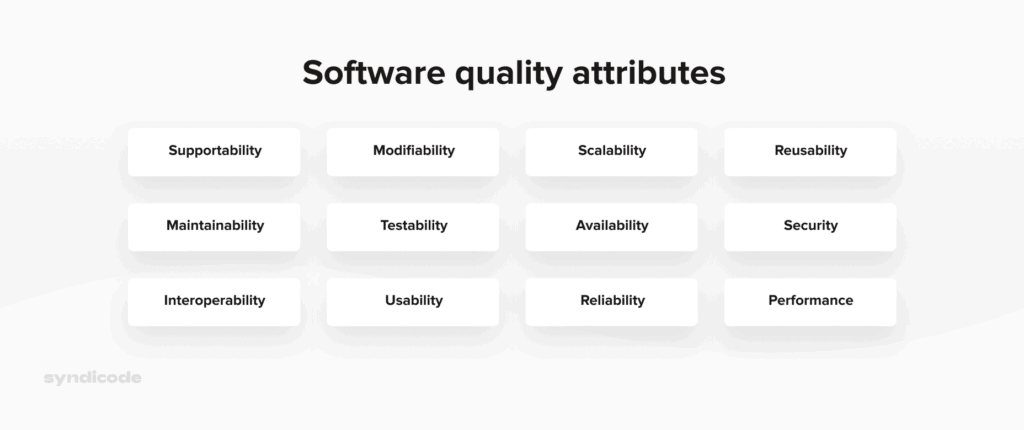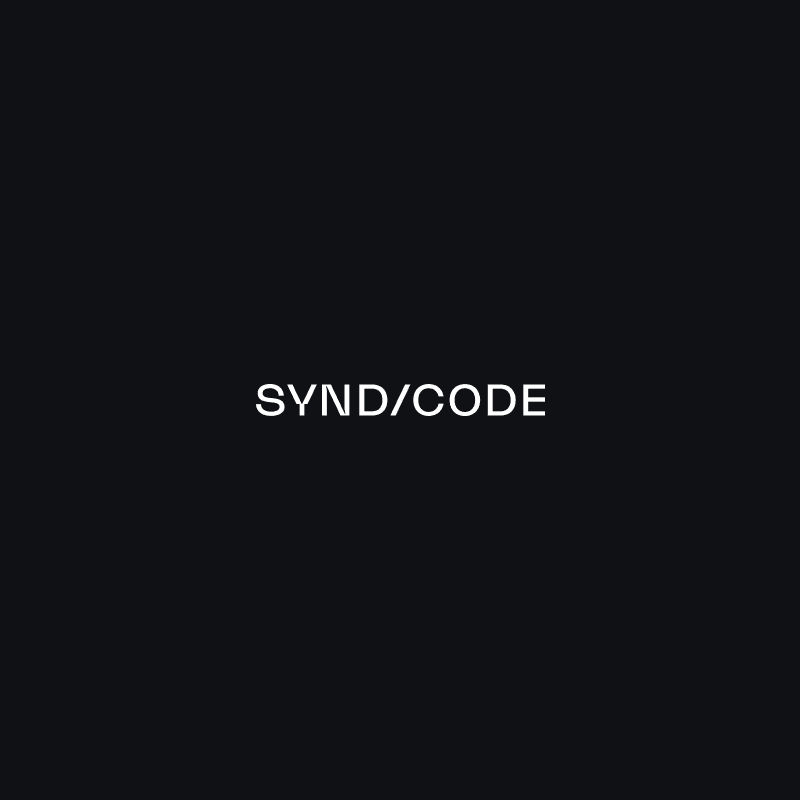Software development companies thrive in creating digital products that demonstrate stable performance and meet technical specifications predefined by the customer at the discovery stage. But how can you test the reliability of an application to ensure it performs as expected? Here come software quality attributes that help technical experts solve this task.
Based on our experience in custom software development, we created a list of the primary attributes of product quality and provided a brief description of each item. This information will help you improve your return on investment (ROI) and develop software products of the highest quality.
12 quality attributes in software architecture
Before we proceed to describe the key attributes of good software, let’s start with the definition of the term in question.
Software quality attributes are measurable or testable properties of a software system used by quality architects. These properties help to determine whether the software satisfies the stakeholders’ requirements and needs.
Below is the list of the most important software architecture quality attributes. You may prioritize them based on your software project needs and requirements.

Usability
This software quality attribute helps define the ease with which users can perform a specific task on the system (registering an account or adding an item to the shopping cart). What issues can be seen as usability problems? These may include inconsistency, too complicated signup process, poor error handling, or unclear navigation, to name a few.
This software characteristic consists of the following sub-characteristics:
- Operability denotes the degree to which a software system or a digital product has qualities that simplify its operation and control.
- User error protection is the degree to which a software system or its components protect users from committing errors.
- User interface aesthetics means the degree to which users get pleasing and satisfying interaction with a software solution or digital product.
Reliability
The term reliability refers to the degree to which a software system or its components performs specific functions under predefined conditions for a certain period of time.
The main sub-characteristics of this software quality are as follows:
- Maturity – is the degree to which a software system meets the standards for reliability during regular operation.
- Availability – means the degree to which a software system can be accessed by the users when it is required.
- Fault tolerance. It is the degree to which a software system performs normally despite hardware or software issues.
- Recoverability. This sub-characteristic describes the degree to which if an interruption or failure takes place, a software system can recover the data directly affected by this failure.
Compatibility
The term compatibility refers to the degree to which a software system or its component can exchange data with other systems or perform its main functions while sharing the same hardware or software environment.
This software quality attribute includes two important sub-characteristics:
- Interoperability defines the degree to which two or more software systems can exchange and reuse the data.
- Co-existence defines the degree to which a software solution can perform its main functions while sharing a common software or hardware environment with other digital products without causing a negative impact on other applications or systems.
Portability
Software portability is a quality attribute that refers to the degree to which a system or its components can be transferred from one hardware, software, or other environments to another.
Here we should take into account the following sub-characteristics:
- Adaptability is the degree to which a software system can be adapted to different hardware, software, or another environment.
- Replaceability means the degree of efficiency to which one software product can replace another software solution designed for the same purpose.
- Installability defines the degree of efficiency to which a software solution can be installed or uninstalled in a particular environment.
Testability
In simple terms, testability determines how easy a software solution is to test to find bugs or ensure that it meets all predefined criteria.
Testability can result from efficient collaboration between the development, product, and testing teams. The development team should consider the testing ability when implementing a new feature. Thus, the input of testers is required to ensure efficient testing.
Scalability
This quality attribute refers to the ability of a software system to handle the increased load without decreasing its performance.
You can improve the scalability of your application in two different ways. First, you can add more resources, namely memory, discs, or processors. That will be vertical scalability.
Alternately, you can add more computing units and divide the load between them. In this case, we talk about horizontal scalability.
The following indicators will help you measure this quality attribute:
- The system’s possibility to be scaled horizontally.
- Scaling limitation, namely the maximum number of servers or the network capacity.
- The growing number of transactions or amount of content, in other words, the possibility to scale.
Flexibility
Flexibility is another attribute of good software products that can easily adapt to future changes.
To be more specific, we say that the application is flexible when it can run smoothly on any device, platform, or operating system. Besides, it can be easily integrated with any other third-party software solution.
A clear advantage of flexible software is that it provides new business opportunities. By enhancing your existing software with new features and integrations, you can gain a competitive advantage in your niche and, thus, drive more customers.
Functional suitability
This quality attribute means the degree to which a software solution or a digital product offers functions that satisfy the predefined needs when utilized under certain conditions.
This characteristic includes the following sub-characteristics:
- Functional completeness implies the degree to which the system’s functionality covers all outlined tasks and user’s goals.
- Functional correctness defines the degree to which a software solution offers the correct results with the required precision degree.
- Functional appropriateness defines the degree to which the product’s features allow for the accomplishment of certain tasks or the achievement of particular goals.
Maintainability
This quality attribute defines the degree of efficiency to which a software solution can be modified for its improvement or adaptation to the evolving requirements or changes in the environment.
Take a look at the following sub-characteristics of this quality attribute:
- Reusability defines the degree to which a system component or an asset can be utilized on several systems or in building other components or assets.
- Modifiability means the degree to which a software system can be effectively modified without causing defects or bugs or decreasing the quality of the existing system.
- Testability shows the degree to which test criteria can be used for the software system, and tests can be performed to determine whether these criteria have been satisfied.
Interoperability
When we speak about the software system’s interoperability, we mean its ability to communicate or exchange data seamlessly between different operating systems, databases, and protocol conditions.
The most common interoperability issues are as follows:
- Legacy internal systems.
- Different formats of data belonging to similar external systems.
- Different API versions in external systems.
- Poor quality or lack of standards for external systems.
You can improve interoperability by creating well-designed external interfaces and system standardization.
Performance efficiency
This software quality attribute shows a software product’s performance relative to the number of resources applied under predefined conditions.
When checking the performance efficiency, consider the following sub-characteristics:
- Time behavior means the degree to which an operating software solution’s response and processing time meet the predefined requirements.
- Capacity is the degree to which the maximum limit of a software product or parameters satisfies the established requirements.
- Resource utilization defines the degree to which the amount of resources utilized by a working software system satisfies the main requirements.
Security
This attribute of product quality refers to the degree to which a software system safeguards the information or data so that users or other systems have the degree of access to these data based on the authorization level.
The main sub-characteristics of this software quality attribute are as follows:
- Confidentiality is the degree to which a software system guarantees that only authorized users can access the data.
- Integrity is the degree to which a software system prevents unauthorized access to a program or data.
- Authenticity is the degree to which the identity of the user or resource can be verified when required.
- Accountability means the degree to which the actions of a particular entity can be monitored and tracked uniquely to this entity.
Conclusion
The list of software architecture quality attributes we discussed above will provide development teams with a clear understanding of how the system should work. Keeping these properties in mind, they will be able to deliver high-quality software solutions that will satisfy all requirements specified by stakeholders.
If you are looking for a reliable technology partner to take on your project, feel free to contact us. Syndicode has great expertise in custom software development.
We build SaaS tools, marketplace solutions, and web and mobile applications for different industries and niches. We will be glad to create a unique digital product for you.
